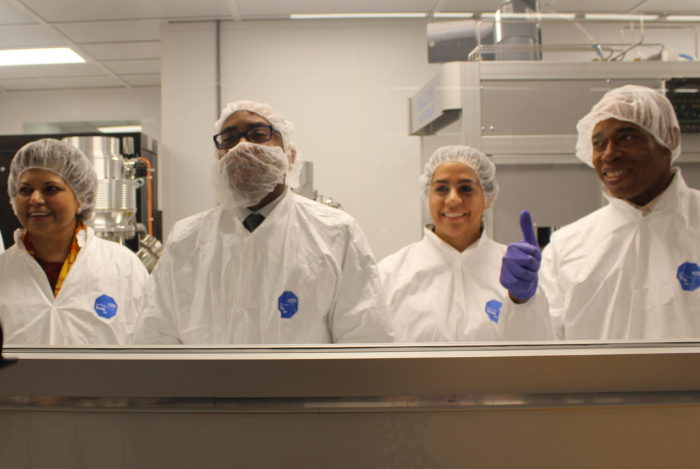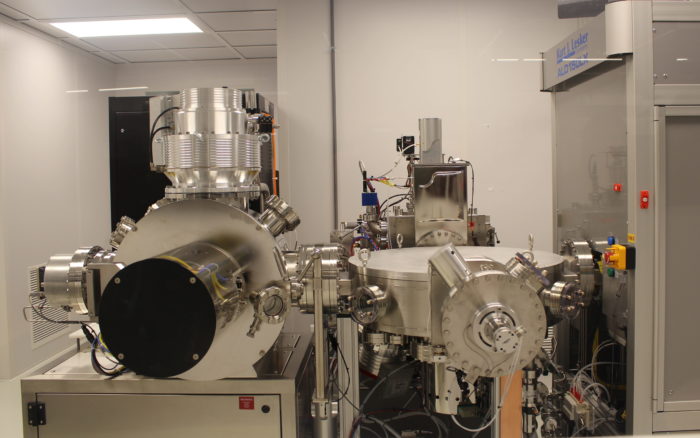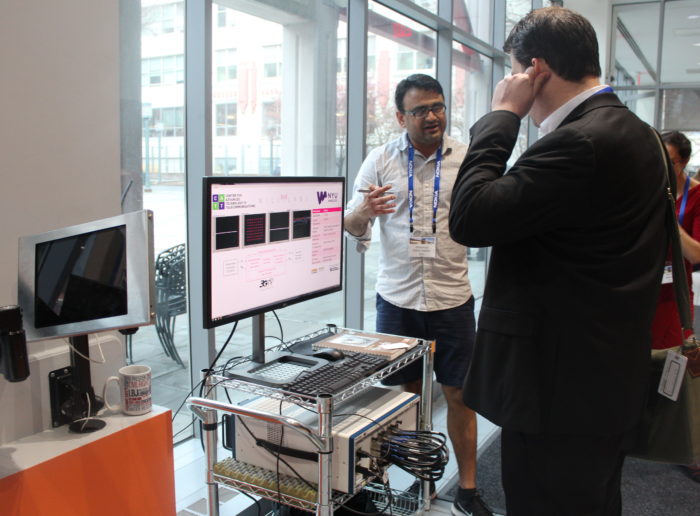A Clean Room, 5G Wireless and NYU Tandon’s Tech Progress
The Brooklyn campus was a showcase this week of new facilities, hyperfast mobile, and cool research projects
NYU Tandon faculty in the new cleanroom with Borough President Eric Adams, far right (Photos by Arden Phillips)
How clean is a “cleanroom”? Incredibly spotless. Brooklyn’s first cleanroom, built for scientific research, was unveiled this week at the NYU Tandon School of Engineering, where educators and public officials donned white suits and hats to explore the pristine facility. Inside, the lab will maintain an environment of fewer than 1,000 particles larger than 0.5 microns per million. To put it in civilian terms, a normal environment has 100 times more dust and pollutants.
The lab, dubbed the NanoFab CleanRoom, is a 2,300 sq. ft. facility that was more than three years in the planning. It will enable scientists and engineers to work on an extremely tiny scale, experimenting in such fields as nanotechnology, quantum computing, and minute biosensors that could revolutionize medicine.

Inside the cleanroom, advanced equipment will support research into fields ranging from nanotechnology to quantum computing
One class of devices that will be developed in the facility will be “future computing devices, faster transistors, faster switching elements that can ultimately be used to fabricate integrated circuits that underlie the wireless systems,” NYU Assistant Professor Davood Shahrjerdi told The Bridge.
Till now, NYU researchers have been using cleanrooms at Columbia University and CUNY, both in Manhattan. Some of that work will move to Brooklyn’s new facility, which will be available for outside researchers as well, including the borough’s many tech startups. The cleanroom was funded in part with $1 million from the office of Brooklyn Borough President Eric Adams, as well as a $2.5 million grant awarded by the Higher Education Capital Matching Grants Program board and administered by DASNY.
Earlier in the week, NYU hosted its annual Brooklyn 5G Summit, where researchers and policy makers gathered to explore innovations in the next generation of wireless technology. 5G is capable of transmitting data at speeds of up to 20 gigbits per second, many times faster than 4G networks. The technology is coming to consumers soon; AT&T, Verizon and other carriers will begin offering 5G to customers in some markets by the end of the year.

At the 5G Summit, exhibitors explained the concepts of their research and new applications
Five years ago, when the Brooklyn 5G Summit first began, the number of mobile-connected devices exceeded the world’s population for the first time in history. Since then, that number has grown considerably; experts predict that by 2020, there will be 20 billion IoT (Internet of Things) devices worldwide, according to NYU.
“Right now your phone might be a 4G smartphone and before that it was a 3G smartphone. 5G represents what the next generation of mobile devices is going to do. And that’s what they’re talking about today: some of the features that they’re going to have, the timelines for these features, and how they’re going to do it,” said Associate Professor Sundeep Rangan, the director of NYU Wireless, an academic research center at Tandon involving 200 faculty and students.
What 5G will bring to our lives, said Rangan, is increased connectivity for both consumers and businesses, given the higher speed of data transmission. “Other types of services can be enabled, more specifically things like cloud connectivity, in the cases when there’s a need for fast connection between the cloud,” he said, and devices in fields ranging from robotics and healthcare to autonomous vehicles.
For example, NYU Wireless is working with the fire department in Austin, Texas, to develop technology for first responders that will convey high-definition images from drones and ambulances, as well as from robots in environments too dangerous for humans, NYU said.
At week’s end, NYU Tandon had one more event: its 2018 Research Expo, where it showcased 70 research projects by faculty and students at the MetroTech campus. All told, the string of events underscored the school’s rapid emergence as a tech powerhouse, which includes the appointment of the school’s first female dean, Jelena Kovačević, who takes charge in August.
“Tandon is very much a school on the rise. There’s going to be about a 30% increase in faculty and a lot of new people coming to do research,”said Andrew Kent, an NYU professor of physics who helped develop the cleanroom. “This is a resource that they’ll be able to use and will also help recruit them, knowing that we have these facilities here.”
“I think it’s amazing what we’re seeing in Brooklyn specifically and in New York more generally,” observed Professor Rangan. “There’s a huge amount of interest in startup companies, in technology companies. Because wireless and mobility will play such a vital role in that, it’s great to have this as an anchor institution in the area.”













